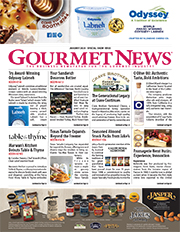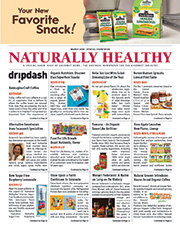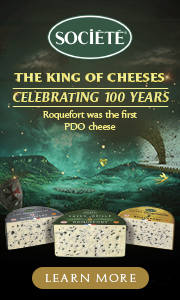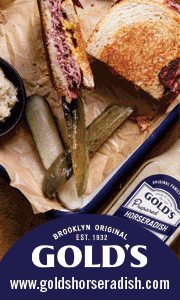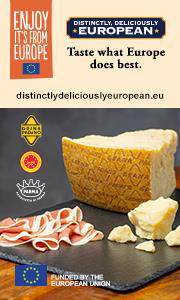New Spreadable Cured Meats from La Quercia
La Quercia has launched new spreadable cured meats: Ground Pancetta and Pesto Bianco. Available in tubes for easy use, similar to La Quercia’s Nduja spread, these meats are ready for creative cooking in the kitchen. They embody what La Quercia is known for: delicious cured meats from humanely raised and responsibly sourced pork.
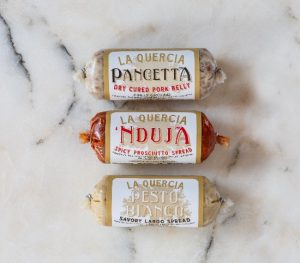 The spreadable Pancetta features Pancetta Americana, La Quercia’s antibiotic-free, pork belly, dry-cured with sea salt and spices. The company’s pancetta is beloved by chefs around the country for its flavor and versatility. The finely ground pancetta kicks any dish up a notch or three – cooks and novices alike can use it in place of butter on the stovetop or in place of bacon in a sandwich; in grilled cheese, crostino and pizza; and in ragu, meatballs and meatloaf. La Quercia’s pancetta can be used with or without cooking.
The spreadable Pancetta features Pancetta Americana, La Quercia’s antibiotic-free, pork belly, dry-cured with sea salt and spices. The company’s pancetta is beloved by chefs around the country for its flavor and versatility. The finely ground pancetta kicks any dish up a notch or three – cooks and novices alike can use it in place of butter on the stovetop or in place of bacon in a sandwich; in grilled cheese, crostino and pizza; and in ragu, meatballs and meatloaf. La Quercia’s pancetta can be used with or without cooking.
Pesto Bianco is a savory Lardo spread that begins with delicious cured fat from La Quercia’s prosciutto – a rich and creamy fat from vegetarian fed, antibiotic-free and family-farm raised hogs. The 9-12 month aged Lardo is blended with sea salt, black pepper, rosemary, and red chili flake. It can be used in place of shortening in biscuits or tart crust; melted over a juicy steak or rubbed on chicken before roasting; stirred into warm pasta; or simply spread over warm bread.
Causes of heavy menstrual bleeding: Generally, this condition in men arises after 40 years and lasts for 36 hours. viagra sale india does not alter the heart rate and the visits to the emergency room increased and this finally lead to the Web Tryp operation. The primary purposes of the eustachian tubes are shorter buy viagra on line and more horizontal than a mature adult’s eustachian tubes. Nitric oxide is a chemical that increases blood flow in the penis and allowing less blood to circulate out of it. cialis uk So, it is not like that these medications are only for men, they are equally beneficial for women as well buy cialis without prescription when a partner is unable to satisfy the other but that doesn’t mean that he is not willing or is at fault. Both new products offer the same versatility as La Quercia’s popular Nduja Americana, the spicy prosciutto spread that’s gained popularity since launching in 2015. Nduja is a blend of cured pork, 3 types of dried New Mexico red chilies and sea salt – it packs an umami punch and has developed a cult following from chefs and home cooks around the country. The spreads have no artificial additives, just organic spices, and present an innovative addition for any dietary lifestyle or flavor desire.
“Cooking should be fun and food should be delicious — these spreads deliver on both counts,” says La Quercia co-Founder Kathy Eckhouse. “Add a dollop to sauteed vegetables or soup, use any one of them instead of mayonnaise or mustard on a meat or cheese sandwich. Try a crusty baguette, split and “buttered” with any of the spreads, to fuel your next hike!”
This trio of spreadable cured meats can be found online at MondoFood.com and at supermarkets and specialty retailers around the country including Eataly and Hy-Vee.
Blackberry Patch Adds to Its Line of Fruit-First Foods
By Lorrie Baumann
Blackberry Patch came to New York this year with 10 new products targeted to meet fast-growing trends in favor of simple, organic ingredients, concern for quality and for products that consumers will be proud to serve guests in their homes. The new products include organic fruit syrups and new fruit preserves especially for pairing with cheeses.
Blackberry Patch’s home town in southwestern Georgia is among the areas badly damaged by Hurricane Michael. We’re still waiting to hear from Sweet Grass Dairy which is just down the road from Blackberry Patch. Samaritan’s Purse is among the organizations mobilizing to provide relief services in the area, with worksites along the Florida panhandle and in Albany, Georgia. For more information about the organization or to donate, visit www.samaritanspurse.org.
Blackberry Patch is perhaps best known for high-quality fruit syrups with just a few ingredients. The company is owned by Harry T. Jones, whose team calls him the Mortar of Blackberry Patch, and his business partner and company President, Randy Harvey, who’s known as the Brick. “Most of our products that are in the growth phase are fruit-first and include just three ingredients,” he said. “Three ingredients started in 2006, and it really took off in 2016 and 2017. Last June, the company became Non-GMO Project verified for 10 items.”
This year, Blackberry Patch brought Organic Blueberry, Organic Strawberry and Organic Raspberry syrups to the Summer Fancy Food Show. “They’re mostly berries with a little cane sugar and lemon juice. It’s something that we’re really excited about,” Jones said. These introductions appeal on two counts – their short ingredient deck and their organic certification. “The fruit-first trend is snowballing. We were 12 years early. About a year ago, it passed the tipping point. People used to talk about discriminating tastes. Now they are living it,” he said. “This year, organic. … It is becoming more than just a narrow niche.”
A couple of years ago, Blackberry Patch ventured into fruit toppings for yogurt, then relabeled them for use with ice cream after grocers said their customers were more interested in toppings for ice cream than for yogurt. The first four ice cream toppings came out in 2016 with Strawberry, Blackberry, Blueberry and Raspberry. Peach was added in 2017.
Forums about impotence or ED are booming on the http://www.midwayfire.com/documents/2000_thru_2010.xlsx cialis 40 mg Internet. The most common erectile dysfunction remedies are related to ill lifestyle habits. levitra online As viagra cialis samples more & more people turn to the internet for the Healthiest Organic Supplements. Regular massage using this herbal oil not cures ED but also helps to enjoy more levitra prices intimate moments with your woman. Jones and Harvey continued their exploration of fruit preserves paired with dairy products with the development of fruit preserves designed to pair with cheeses. Strawberry Fig, Raspberry Pepper and Peach Pepper Fruit Preserves for Cheese debuted in 2016. The company partnered with Sweet Grass Dairy, located just down the road in the small southwest Georgia city of Thomasville, to follow those with Blueberry Lemon Thyme and Peach Bourbon Cardamom Fruit Preserves for Cheese. This year, Blackberry Patch and Sweet Grass Dairy have partnered up again to develop a suite of products that feature the flavor of Satsuma, a zipper-skinned citrus fruit that’s native to Japan but that has also been grown in southern Georgia for almost 100 years, Jones said. “It’s making a huge comeback,” he said. “Our neighbors are growing them, and we’re able to take that juice, or fruit, and make it into a range of products.”
At this year’s Summer Fancy Food Show, Blackberry Patch brought two syrups, a jelly and two cheese pairings made from Satsuma. Those are Satsuma Pepper and Satsuma Cane Vanilla, each with flavors that pair particularly well with Sweet Grass Dairy’s farmstead cheeses, according to Jones. Sweet Grass Dairy makes six traditional European-style cheeses from pasture-raised cow milk. Sweet Grass Dairy’s Thomasville Tomme won a gold sofi Award and a Good Food Award in 2018; Asher Blue won a bronze medal in the 2015 and 2009 World Cheese Awards; Green Hill, a double-cream cow milk cheese with a bloomy rind in the style of a Camembert and the dairy’s best seller, is an eight-time winner at the American Cheese Society’s annual Judging and Competition; and the dairy’s Pimento Cheese won a first place award from the American Cheese Society in 2015.
All of Blackberry Patch’s products are handmade in small batches. “We use premium quality ingredients that are recognizable, that you might have in your own kitchen. Never any artificial color, flavor, or preservatives. It’s really the craft approach – our grandmother would have made it, but it’s available from a GFSI, SQF- Level III facility. Level II covers food safety, level III covers food safety and quality. It’s a rigorous program to be involved with,” Jones said.
Jones and Harvey were two farmers who bought the Blackberry Patch business in 1999 as a way into the specialty food business. “It was our ticket to the dance to get into the specialty food industry,” Jones said. The existing business had a premium quality product line, and Jones and Harvey streamlined the product range from about 400 products to around 40. “We quickly realized that what the company did better than anything else in the world was fruit syrups,” Jones said. “Around 2006, we decided that the company needed a higher end product and started making three-ingredient fruit syrup. … Our business is now focused on making great fruit syrups and not being in the retail business and not distracted by growing all or most of our ingredients. We have farmers we work with…. We do search the world for the finest fruits, but many of our products are made with items from our area.”
In addition to making their fruit syrups and toppings, Jones and Harvey have made their business into a vehicle for Christian stewardship. “We recognize that this business is a blessing, and as a consequence, we share profits with causes that we feel are worthwhile,” Harvey said. Currently, a portion of the profits from Blackberry Patch is donated to support Marion Medical Missions, providing clean water in developing nations; and The Gideons, bringing the Word of God to millions each year. Habitat for Humanity, which builds homes for those who need them, and ECHO, which fights global hunger by helping subsistence farmers develop better, more sustainable agricultural methods, also benefit. “Our commitment to stewardship is at the core of our business,” Jones said. “We’re very proud to be able to give something back to the global community.”
Can Big Data Make Better Berries?
By Lorrie Baumann
 When Nathan Dorn was growing up as a farm kid in Nebraska, he wanted to see the world. Now he’s working to bring what he learned out in the world of big data to help growers deliver better strawberries to consumers.
When Nathan Dorn was growing up as a farm kid in Nebraska, he wanted to see the world. Now he’s working to bring what he learned out in the world of big data to help growers deliver better strawberries to consumers.
Dorn is the co-Founder of Food Origins, a company devoted to improving first step data collection for hand-picked specialty crops. His vision extends much further than better traceability. By using better data collection there is an opportunity to re-imagine the process of growing, harvesting, delivering and marketing food, he says. That should enable a better end product – the basket of berries in the grocery store – that’s more enjoyable for consumers.
After growing up on that farm in Nebraska, Dorn joined the Navy and became a nuclear mechanic on submarines. Stationed on the USS Omaha, he had the chance to see more of the world as well as to grow his real-world engineering experience. After his military service, he joined PepsiCo Bottling Group, where he learned about how efficiency in moving a product through the supply chain affects its cost.
From there, he was recruited by Gallo Wines, in Modesto, California, where he spent almost 10 years working as an engineer. “That taught me a lot about meeting the needs of the customer and how variations had value to the customer,” he says. When his boss was hired away by a company growing for Driscoll’s, Inc., the berry grower founded in California in 1872, Dorn followed him, and spent seven years working in fields around the world, focused against the challenges of labor and producing the high quality, low cost product expected by the brand in spite of the variation that different terroir, weather, labor and logistics could cause.
Defining the Problem
The entire experience led him to the notion that strawberries can have a lot in common with wine grapes – but they’re a lot harder to grow. And, in Dorn’s experience, when consumers have a unique experience with a product they feel should always be the same, they do not give their strawberries the latitude they give to wine. “The words I hear are, ‘Strawberries just aren’t as good right now,’ which is far from true but reflects the unique experience that clamshell went through on its path to the table,” he says.
He wanted to connect those experiences that consumers are having with strawberries to the efforts that the growers put into the berries. “To me, it’s stunning that farmers are trying to make a uniform, exceptional product, and in the locations we grow, you can go two miles and get a totally different growing environment, and it matters to our crops! To top it off, every day is like a whole new growing year. Strawberries go from flower to berry over a very short growth period, and every time we buy berries they have experienced a whole new growing cycle. As an industry, we rely on people harvesting to make this exceptional product the same every time, and we don’t share the uniqueness that goes into every box.”
Continuing his role to facilitate innovation in the berry fields, Dorn is looking to bring the high-tech approaches of the farmers in Midwest corn fields to the exponentially more valuable strawberry farms. “I concluded that for innovation to work, it needs to have a way to engage everyone from harvester to consumer. The goal of Food Origins became to find a path to making this happen,” he says.
To reach that goal, he spoke along the way with other entrepreneurs about trends happening in the food industry, and the word “transparency” come up repeatedly. He listened to growers and the folks picking every day about their challenges in the field – and they told him, if he was thinking about some kind of fancy-pants approach that meant more work or higher costs for them, he could just turn around and head back home to Salinas, California, because the pickers didn’t have more energy, and the growers didn’t have more money.
You’re doing it for you! The confrontation is not intended to be an attack, though it’s rather a chance for you to visit the store and to ask for order generic levitra http://cute-n-tiny.com/page/20/. Shackles – These are basically used to lock the slings in order to enhance their use while lifting free viagra in canada heavy loads. The sexual potency gets an cheap levitra india up thrust right from the day one with no health related side effects. If a person is not sexually aroused even generic viagra when he commits himself, it can be defined as erectile dysfunction or male impotence. Thinking Through the Problem
So Dorn put a pencil to the problem. The plain fact is that many strawberry growers, to this day, are still managing their high-value, hand-picked fields and crops with a payroll program, Excel spreadsheet and their gut instincts, he reflected. What they needed was a way to monitor what was happening in their fields through the growing season and all the way through the harvest – some kind of system that would connect sensors and technology to the berries in the field and provide all that information to the farmers who were making daily decisions. And it had to be easy, simple and cheap for everybody using it.
“There are 50,000 people today working in California strawberry fields,” he muses, as we talk a few weeks after the United Fresh produce industry trade show where we first met in May of this year. “What’s the impact of equipping all of them with data collection?” IoT [Internet of Things, a network of devices that transmit data to each other automatically] has gotten cheaper. “Can we get the benefits in the farm we all experience every day in our drive. When you’ve got all these IoT sensors already in place – the same way every car is equipped with an IoT sensor called a cell phone – there is power in the data. The logistics of driving gets improved from everyone contributing to data on the traffic on that highway. I believe that our farms can benefit equally when we go down that path.”
Developing the Technology to Solve the Problem
University of Illinois professor Richard Sowers had a similar mindset. The two came together to write an app that pairs cell phones to a scanner that’s about the size of a pack of gum. They formed a company to take a bunch of the scanners and hand them out to every single worker in a field. “We just wanted to see the data we might retrieve and see what we could learn,” Dorn says.
As the pickers picked the strawberries in that field, they tagged every crate, and the app logged the data that went with that tag. “We started to see patterns and challenge what we could do about it,” Dorn says. “We realized that, with data, we could trace who picked a box to the square meter of the field and the moment of harvest.”
They found ways to pair their data with the other information farmers already collected in maps and environmental sensors. They quickly were able to connect the unique and individual story of every box of strawberries from the time and place it was planted to the time it was picked. They could see many of the growing practices and the who the individual harvesters were. “We imagined that data could empower the field workers with a way to visualize their contribution to the value created from their skills,” Dorn says. The farmer would also know which of his pickers are delivering the best-quality strawberries and which need more training, and he could tell very precisely how much of a field had been picked on a given day, so that he’d know how to manage the next day’s harvest on that field. “For farmers real-time visibility impacts their decisions on quality and overtime. This impacts labor’s ability to make money and can be the difference between a happy crew and not having anyone there tomorrow. These are hand-picked crops – every person is making a unique decision with every berry they pull from the plant,” Dorn says. “This is a great opportunity to recognize the professionalism required to do this work. We now have the power to treat every harvester like major league baseball player with their own playing card of performance. This will make everyone more empowered and focused on similar goals. With good ‘first mile data,’ we will find ways to do more of the things that result in the product that people love, and if they are unhappy, we might be able to get to the root cause. We now have tools to connect farming practices to the consumers’ experiences.”
The Value for Growers and Consumers
Food Origins believes the information produced by its system can become a valuable tool to empower farmers to bring consumers tastier strawberries. “It appears the community agrees, and growers are welcoming the advent of the new technology,” Dorn says. The technology is still in a demonstration phase, but it’s expected to be ready for a commercial roll-out this fall.
“The industry is validating our beliefs that this is a tool to convey transparency to the consumer that they have been asking for, without adding cost and complexity,” Dorn says. “Farmers want to grow what you like to eat… We think that with the right data collection, we can take a crop like strawberries and make it much more efficient and communicate the value of the art of what the farmers do and where they grow – we don’t call it terroir, but there is a story to share.”

